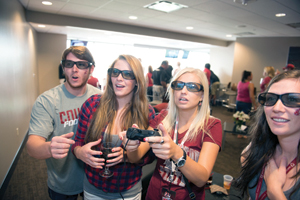Washington State University has rolled out 3-D technology in the suites at Martin Stadium, which industry experts believe is the first sports facility in North America to complete a permanent installation.
A company called 3D-4U, co-founded by Sankar Jayaram, a Washington State professor of mechanical engineering and computer science, has developed proprietary technology that gives suite users exclusive access to live action and replays in 3-D on 47-inch high-definition televisions.
 |
Fans control cameras and angles.
Photo by: RAJAH BOSE
|
The technology gives patrons control over four unique camera feeds placed in both end zones and on the 25 yard lines on the stadium’s south sideline, where 21 new suites opened this season as part of a $65 million stadium renovation. Using a remote control device, fans in the suites get to choose the camera angle they prefer with the ability to pan, tilt and zoom in on the action. They can navigate their own replays and focus the automated cameras on individual players.
To view the technology in 3-D, suite attendees must wear 3-D glasses provided in every skybox. The unique camera angles can also be viewed in traditional 2-D format, Jayaram said.
The ability for a fan to take control of a live television camera in a suite is not new — Sony and Daktronics teamed up three years ago to form StadiumView at Great American Ballpark in Cincinnati — but upgrading it to 3-D is a groundbreaking venture, experts said.
As the quality of 3-D technology continues to improve, 3D-4U could gain traction in sports by providing fans with a “total immersion” experience, said Sandy Climan, president of Entertainment Media Ventures and former CEO of 3ality Digital. Climan’s old company produced the first NFL game in 3-D in 2008.
“I will be watching closely to see the quality and comfort of the 3-D broadcast at Washington State,” he said.
Washington State invested $700,000 in the technology, said John Johnson, the school’s senior associate athletic director. Jayaram said the costs can run as high as $3 million depending in part on the number of 3-D cameras operating on the field.
The market for 3-D televisions remains spotty three years after the first units hit retail stores. There are fewer than 115,000 homes in the U.S. tuned to 3-D channels at any one time, according to a recent story from The Associated Press.
Jayaram said the technology has the potential to generate revenue for schools using the system for advanced coaching tools, high-resolution security and surveillance and on-demand highlights.
In addition, 3D-4U is developing a mobile application for fans to maneuver camera angles similar to what can be done in the suites. The application will start in 2-D format, but is designed for 3-D once smartphones and tablets fully catch up with the technology, Jayaram said. Company officials expect to roll out the application in November. Mobile devices with 3-D technology do not require users to wear glasses, he said.
Jayaram has worked on 3-D technology for 12 years and co-founded 3D-4U in 2004. Silver Chalice, a new-media subsidiary of the Chicago White Sox, bought an undisclosed percentage of the company in 2010.
Last year, 3D-4U tested its system at the National League Championship Series at Busch Stadium, where company officials in conjunction with Major League Baseball Advanced Media placed a camera in the dugout and recorded the games. It was also tested at NBA and NCAA football games, Jayaram said.
Silver Chalice is leading the effort to introduce 3D-4U technology to leagues, right holders and media companies, said Jason Coyle, its chief operating officer.
The feedback from teams has been to use the technology as an enhanced 2-D experience without upgrading to 3-D, Coyle said. That being said, 3D-4U is “well-positioned if the marketplace ever opens up,” he said.
“The output is unlimited,” Coyle said. “There could be 1 million users looking at 1 million things at the same time. There are remarkable opportunities if they can just get a foothold.”




